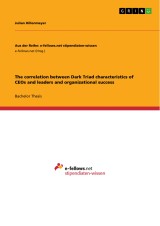Details

The correlation between Dark Triad characteristics of CEOs and leaders and organizational success
Aus der Reihe: e-fellows.net stipendiaten-wissen 1. Auflage
|
16,99 € |
|
| Verlag: | Grin Verlag |
| Format: | |
| Veröffentl.: | 24.09.2024 |
| ISBN/EAN: | 9783389071656 |
| Sprache: | englisch |
| Anzahl Seiten: | 39 |
Dieses eBook enthält ein Wasserzeichen.
Beschreibungen
Bachelor Thesis from the year 2024 in the subject Business economics - Business Management, Corporate Governance, grade: 1,0, University of Augsburg, language: English, abstract: This thesis will explore the implications of dark triad traits in leadership, aiming to provide a comprehensive understanding of how these traits influence organizational outcomes within different environments, based on the research question: "Investigating the correlation between Dark Triad characteristics of CEOs and leaders and organizational success". By examining this fundamental relationship, we aim to contribute to the growing body of literature on leadership personality and its impact on corporate performance, putting particular emphasis on the dark triad traits. Understanding these dynamics is not merely a valuable academic exercise but holds significant practical implications for executive selection, corporate governance, and organizational strategy in an increasingly complex business landscape.
To comprehensively address the research question from multiple facets, this study is organized as follows: It starts by contextualizing dark triad traits in a business context, highlighting their prevalence among corporate leaders. The thesis then explores three established theories – upper echelons theory, social exchange theory, and self-affirmation theory – and examines their relevance to this concrete research. Subsequently, the interplay of dark triad characteristics in leaders and CEOs gets investigated. Building on a general overview, the paper further investigates the interactions between dark triad characteristics in leaders and CEOs through assessing both the positive and negative influence these traits have on organizational outcomes. The final section of the literature review specifically addresses situational and contextual variations in these effects. Following this, the methodology section outlines the process employed to identify eligible literature. Lastly, the key findings of the research are succinctly synthesized, culminating in a concluding discussion appraising the implications of these results.
To comprehensively address the research question from multiple facets, this study is organized as follows: It starts by contextualizing dark triad traits in a business context, highlighting their prevalence among corporate leaders. The thesis then explores three established theories – upper echelons theory, social exchange theory, and self-affirmation theory – and examines their relevance to this concrete research. Subsequently, the interplay of dark triad characteristics in leaders and CEOs gets investigated. Building on a general overview, the paper further investigates the interactions between dark triad characteristics in leaders and CEOs through assessing both the positive and negative influence these traits have on organizational outcomes. The final section of the literature review specifically addresses situational and contextual variations in these effects. Following this, the methodology section outlines the process employed to identify eligible literature. Lastly, the key findings of the research are succinctly synthesized, culminating in a concluding discussion appraising the implications of these results.

















